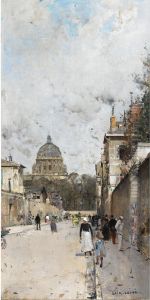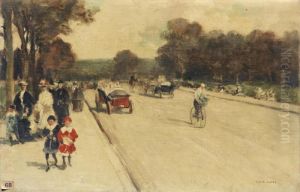Aloys Francois Joseph Loir Paintings
Aloys Francois Joseph Loir, born in 1845 and passing away in 1916, was a notable French painter and illustrator who emerged as a significant figure during the Belle Époque period, a time characterized by cultural flourishing and economic prosperity in France and other Western countries towards the end of the 19th century and the beginning of the 20th century. Loir's work is distinguished by its vibrant depiction of Parisian life, incorporating elements of impressionism and realism to capture the dynamic and evolving urban landscape of Paris during this period.
Loir's artistic journey began with his education at the École des Beaux-Arts in Paris, where he studied under the guidance of established artists such as Jean-Léon Gérôme and Isidore Pils. His early work primarily consisted of historical and genre paintings, but he gradually shifted his focus towards the urban scenery of Paris, inspired by the city's transformation under Baron Haussmann's renovation projects. This shift marked a significant turning point in Loir's career, as he began to chronicle the life of the Parisian bourgeoisie, the bustling boulevards, and the picturesque scenes of the Seine River.
Throughout his career, Loir participated in various exhibitions, including the prestigious Paris Salon, where he received critical acclaim for his contributions to French art. His paintings were celebrated for their luminosity, meticulous detail, and the ability to evoke the atmosphere of the locations he depicted. Besides painting, Loir was an accomplished illustrator, contributing to popular periodicals of the time and creating posters, which further solidified his reputation as a chronicler of contemporary Parisian life.
Loir's legacy is that of a painter who captured the essence of a rapidly modernizing Paris, reflecting both the optimism and the complexities of the Belle Époque era. His works remain an invaluable record of this transformative period in French history, providing insight into the social dynamics, architectural innovations, and the vibrant culture of Paris at the turn of the 20th century. Although not as widely recognized as some of his contemporaries, Loir's contribution to the arts continues to be appreciated by art historians and collectors alike, celebrating his unique perspective on a pivotal era in European history.

